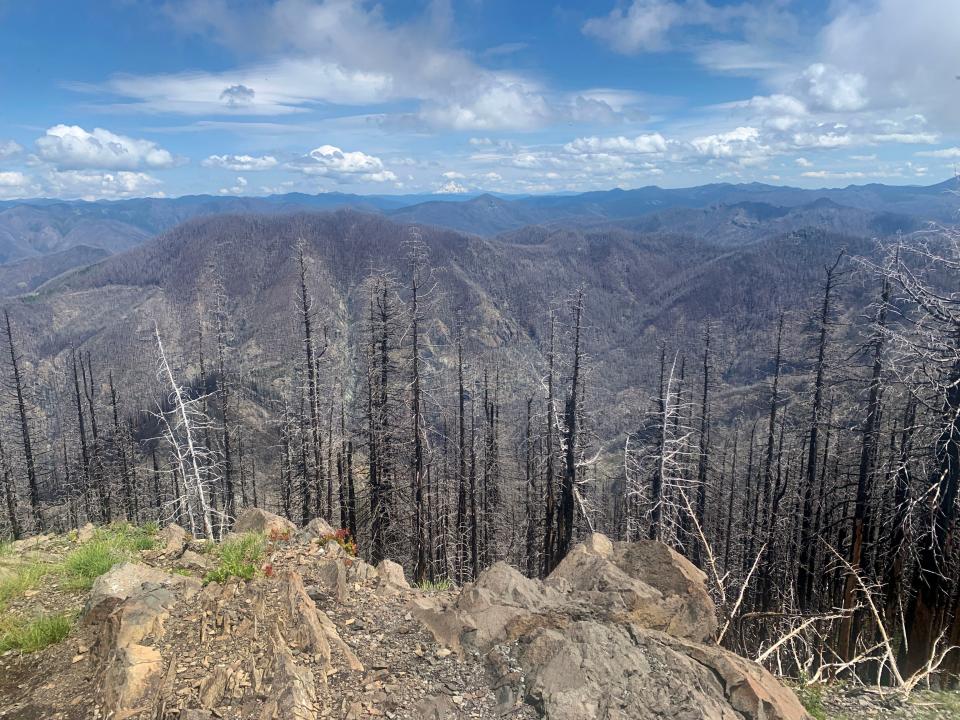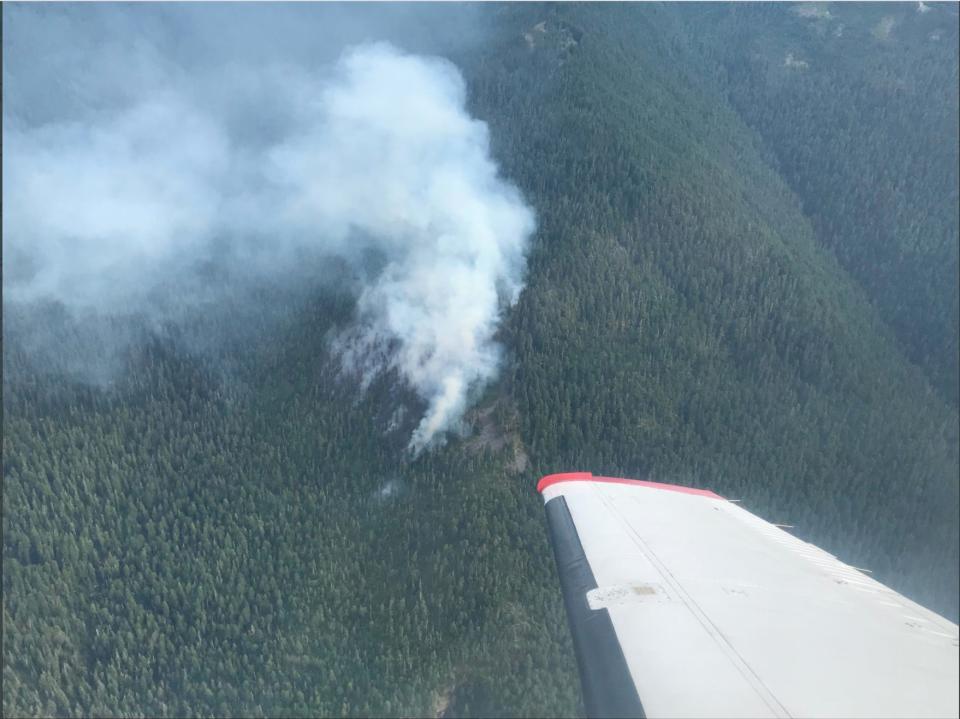Oregon timber company sues Forest Service for not putting out 2020 wildfire before blowup
An Oregon timber company has sued the U.S. Forest Service for $33 million for not putting out a fire in 2020 before it turned into a raging inferno.
Freres Lumber Co., based in the Santiam Canyon, contends the service's “negligent failure to follow its own mandated fire attack plan” led to one of the largest and deadliest wildfires in state history.
The Beachie Creek Fire originated in the Opal Creek Wilderness, located in in Marion County, Ore., in mid-August 2020, most likely ignited by lightning and remained small for weeks. In early September, the fire started to grow and then exploded during historically powerful east winds on Sept. 7 and 8. That fire eventually merged with fires ignited by downed power lines in the Santiam Canyon.
The combination Santiam-Beachie Creek fire burned 193,000 acres, killed five people and destroyed hundreds of homes.
Company President Rob Freres said the fire burned one-third of the company’s private timberland — or about 5,800 acres.
“That fire will affect our business for the next 50 years,” he said.
US wildfire, smoke map: Track latest wildfires, red flag warnings across the US
'Forest Service failed' to drop water on Oregon wildfire at center of lawsuit
The thrust of the lawsuit is that the Forest Service decided the Beachie Creek Fire was a “full suppression fire” but did not commit its resources to putting out the blaze.
“The Forest Service failed to sufficiently utilize the helicopters that were available to suppress and contain the Beachie Creek Fire,” the lawsuit says. “Its initial attack, which the Forest Service recognizes as the best opportunity to control a wildland fire, was entirely unsuccessful at containing the fire, leaving the fire 0% contained. After that failed initial attack, the Forest Service failed to drop any water on the fire for nearly two weeks.”
“As a result of the Forest Service’s negligent failure to follow its own mandated fire attack plan, the Beachie Creek Fire grew from a smoldering 3.5 acres into a firestorm."


The lawsuit seeks compensation for "lost timber and related damages that are a direct result of the Forest Service’s negligence.”
An investigative story published in January 2021 by the Salem Statesman Journal, part of the USA TODAY Network, detailed how the Forest Service managed the Beachie Creek Fire before its blowup. Among other things, it found fire crews dropped 620,000 gallons of water on the Beachie Creek Fire while it was still small and confined it to a remote part of the Opal Creek Wilderness. But they also went nine days without dropping any water, never used fire retardant and didn't engage the fire on the ground, according to U.S. Forest Service records.
The Forest Service wouldn’t comment on the lawsuit, but in previous stories about how they managed the fire, officials said simply dropping water on the fire would not put it out and they needed ground firefighters to contain it. But two elite hotshot firefighting units turned down the assignment to fight the fire “direct” on the ground, because of the extremely steep, remote and dangerous terrain.
Therefore, the fire crews moved to a “containment” strategy of attempting to keep the fire inside fire lines built around it. They said calls for using fire retardant and additional resources were denied due to other higher priority wildfires.
Freres isn’t convinced.
“We feel like they were grossly negligent in not fully suppressing the fire when they had weeks to do it,” he said. “It was aggravating to see helicopters just parked at the Gates airfield while we could see smoke coming out of the forest for weeks. Because of their actions we lost one-third of all the timberland we have. We won’t be able to harvest 3 million seedlings that we had planted.”

Uphill battle in suing federal government for fire management
Legal experts say Freres will have a difficult time successfully suing the federal government for how it managed a wildfire and that similar cases have been unsuccessful.
The government enjoys a high level of immunity from lawsuits. There are some exceptions, including the Federal Tort Claims Act, which Freres is using, that does allow individuals and businesses to sue for injuries caused by negligent acts of government employees.
To succeed, Freres lawyers would likely need to show the Forest Service violated a mandatory firefighting rule, policy or plan.
“Yes, the government does have immunity in many cases,” Freres said. “In this case we believe we can overcome that because they deemed it a full suppression fire and didn’t fully suppress it. They failed to follow their own rules.”
Andy Stahl, an environmentalist who has been part of numerous public lands lawsuits, said he doesn’t think the lawsuit will go anywhere. Under the FTCA, firefighters are given the benefit of “discretionary function” or the ability to make decisions about how they fight a fire, Stahl said.
He noted that the 10th Circuit Court of Appeals recently upheld dismissal of a similar lawsuit over a 2018 Wyoming wildfire because, the judges ruled, decisions on how to manage the fire were “best lodged with officials and experts on the ground than with judges aided by the benefit of hindsight,” wrote judge Timothy Tymkovich.
“They have great lawyers, but Freres faces an uphill battle,” said Stahl, executive director of Forest Service Employees for Environmental Ethics. “I don’t think this case will ever get before a jury.”
More: Jury awards 9 survivors of 2020 Labor Day fires $85M after verdict against PacifiCorp
Freres part of two lawsuits over Beachie Creek Fire
Freres isn’t only suing the Forest Service. They’re also part of a major class action lawsuit against the utility Pacificorp.
Last June, a jury found Pacificorp negligent for its power lines igniting and helping spread wildfires in the Santiam Canyon that eventually merged with the original Beachie Creek Fire.
Freres said based on the boundaries drawn, the fires started by Pacificorp burned 12% of the 5,800 acres the company lost. The other 88% of the forest lost, or roughly 5,104 acres, came from the original fire that was being managed by the Forest Service.
Freres is scheduled to take part in a “mini trial,” along with one other timber company, against Pacificorp in April to determine damages paid out by the utility. However, Freres said the company is beginning mediation in hopes the trial can be avoided.
Zach Urness can be reached at zurness@StatesmanJournal.com or on X, formerly Twitter, @ZachsORoutdoors.
This article originally appeared on Salem Statesman Journal: Forest Service sued by timber company over 'failed' wildfire response

